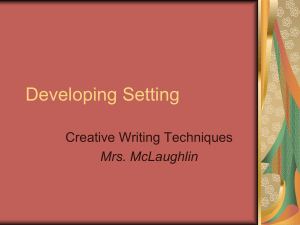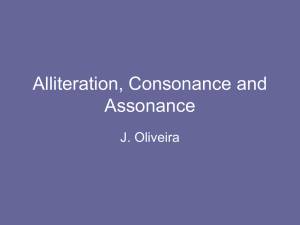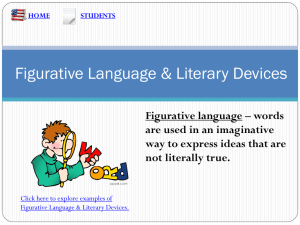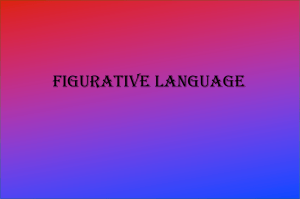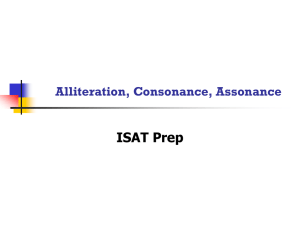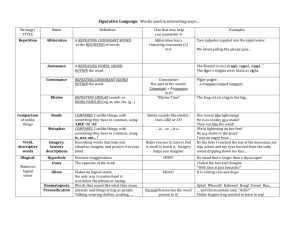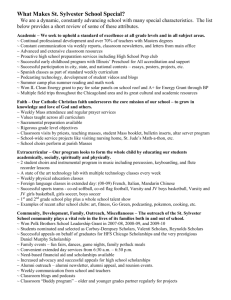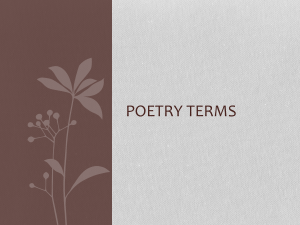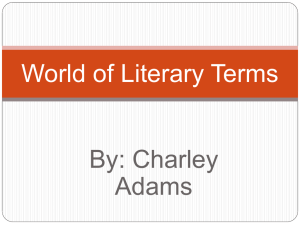Y2 Q3 Dialectic English Fiction Writing Guide
advertisement
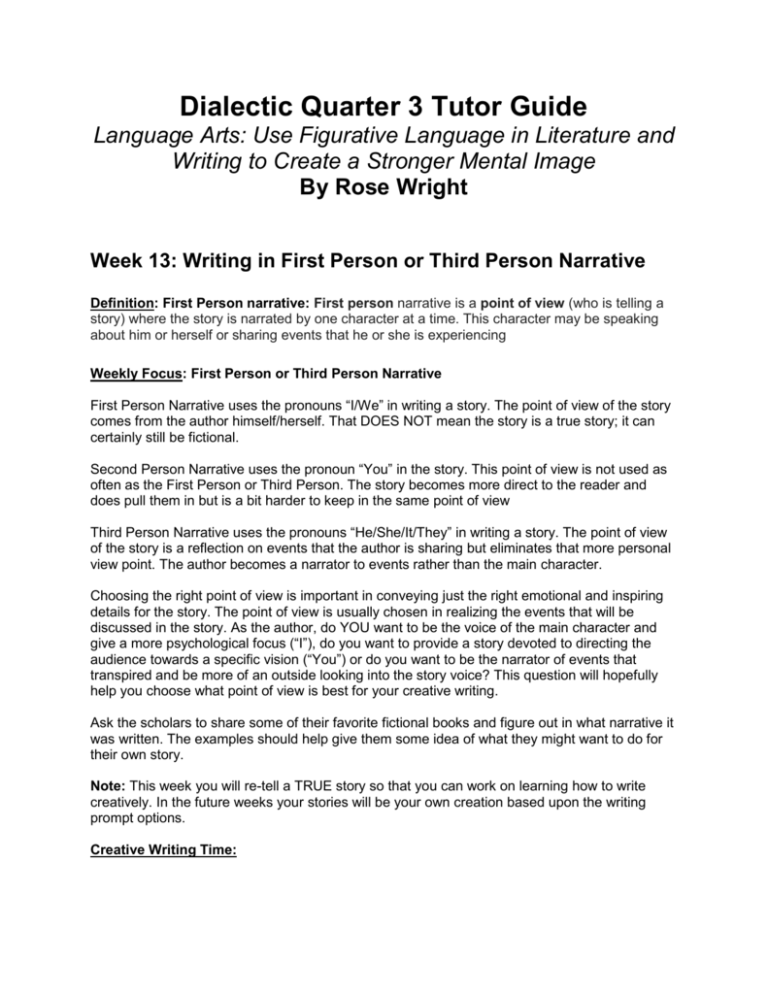
Dialectic Quarter 3 Tutor Guide Language Arts: Use Figurative Language in Literature and Writing to Create a Stronger Mental Image By Rose Wright Week 13: Writing in First Person or Third Person Narrative Definition: First Person narrative: First person narrative is a point of view (who is telling a story) where the story is narrated by one character at a time. This character may be speaking about him or herself or sharing events that he or she is experiencing Weekly Focus: First Person or Third Person Narrative First Person Narrative uses the pronouns “I/We” in writing a story. The point of view of the story comes from the author himself/herself. That DOES NOT mean the story is a true story; it can certainly still be fictional. Second Person Narrative uses the pronoun “You” in the story. This point of view is not used as often as the First Person or Third Person. The story becomes more direct to the reader and does pull them in but is a bit harder to keep in the same point of view Third Person Narrative uses the pronouns “He/She/It/They” in writing a story. The point of view of the story is a reflection on events that the author is sharing but eliminates that more personal view point. The author becomes a narrator to events rather than the main character. Choosing the right point of view is important in conveying just the right emotional and inspiring details for the story. The point of view is usually chosen in realizing the events that will be discussed in the story. As the author, do YOU want to be the voice of the main character and give a more psychological focus (“I”), do you want to provide a story devoted to directing the audience towards a specific vision (“You”) or do you want to be the narrator of events that transpired and be more of an outside looking into the story voice? This question will hopefully help you choose what point of view is best for your creative writing. Ask the scholars to share some of their favorite fictional books and figure out in what narrative it was written. The examples should help give them some idea of what they might want to do for their own story. Note: This week you will re-tell a TRUE story so that you can work on learning how to write creatively. In the future weeks your stories will be your own creation based upon the writing prompt options. Creative Writing Time: Scholars may choose one of the following topics with a specific point of view. All stories must be short stories in order to get them done by next week. Mention to the scholars that each week if time allows, you will have sharing time (Tutors may do this share time to their liking as explained in the next week.) Finally, students should keep in mind the 4X4s of Effective Essays while writing their stories. Even though these stories are not academic essays, they still should have the good quality writing found in essays. Two successful helps will make their story stronger: Helpful Hint 1: Avoid the “to be” verb (is, was, were) when possible by using action verbs that describe a scene more vividly. Helpful Hint 2: Use adjectives and adverbs as much as possible. A good story always embellishes with wonderful imagery. If you do nothing else for this first week of writing, ADD adjectives/adverbs when you look back over your work! That will help your writing be more creative. Option 1: Write a story about your childhood (in First Person Narrative). Option 2: Write about a family member’s story (in Third Person Narrative). Option 3: Write a story about either a favorite memory you or a loved one has shared or a sad tragedy that turned out all right in the end that you or a loved one has shared (can be in either First Person or Third Person Narrative). Week 14: Using colors to give a deeper meaning to the story Definition: Fiction Writing Fiction writing: 1. literature in the form of prose, especially short stories and novels, that describes imaginary events and people. (from Oxford dictionary) Examples of Fiction Writing: Modern fiction (written about current events but still a fictional story), Historical fiction, (written in a particular time period but not a true story). Genres of fiction writing can be mystery, fantasy, romance, historical, comedy, etc. Fictional writing can have short, medium or long sentences, but they must flow smoothly and draw in the reader so that he/she is compelled to continue reading. Weekly Focus: Color Various techniques make creative writing successful. This week the focus will be on color. Color given to descriptions can have a secondary meaning Red: Blood, love, murder, passion Black: death, darkness, night, evil, mystery, secrecy Green: spring, life, envy Yellow: death, decay but can also be joy, happiness (depending on brightness of the color) White: Purity, light, goodness, innocence, color of perfection Pink: Love (remember though pink is made with red and white so that can have additional meaning) Blue: calm, peace, relaxing but can also be used to indicate depression, gloom. Purple: royalty, wealth Brown: poverty, earth, dirty Sharing Time: (Optional considering how much time you need to give to explanation of weekly focus) Option 1: Try to read some of the stories beforehand and pick one you would like to share with the class. Option 2: Ask if anyone in the class would like to share their story. Option 3: If you feel students still need work on polishing their creative writing skills before presenting to the class, provide a short story as an example for them and read it aloud. Ask them to listen as you read for ideas they could have applied in their writing. Creative Writing Time: Scholars may choose one of the following topics and make sure to include at least FOUR different colors in their description implying the secondary meaning. All stories will have to be short stories due to time constraints. What they do not finish in class they should finish at home. Option 1: Write a short story from the perspective of a sailor on one of St. Paul’s journeys. You can do this in First Person (writing using “I”/”we”) or Third person (writing using “he/she/it/they”). Option 2: Write a short story that takes place during a winter storm. Extra Challenge: Scholars can add in a mystery package somewhere in the story. Option 3: Write a short story based upon a favorite story you have already read (Ex. The Lion, Witch and the Wardrobe, Goldilocks and the Three Bears: Write an adventure about the four characters or continue the story. Week 15: Emotion in writing: similes and metaphors Definition: Simile: a figure of speech involving the comparison of one thing with another thing of a different kind, used to make a description more emphatic or vivid (e.g., as brave as a lion, crazy like a fox). Metaphor: making an implicit comparison between two unrelated things that may share a common characteristic. Does not use like or as (e.g. He is the black sheep of the family). Weekly Focus: Emotion and Similes Creative writing needs to show emotion. That emotion can be given in use of color (like we learned last week) or it can be used in comparison to other things. Using similes makes a direct comparison between two different objects using like or as (In the mornings, my father is cranky like a bear), or (upon first awakening, my father is as cranky as a bear, just coming out of hibernation). Sharing Time: (Optional considering how much time you need to give to explanation of weekly focus) Optional for Tutors: Option 1: Try to read some of the stories beforehand and pick one you would like to share with the class. Option 2: Ask if anyone in the class would like to share their story. Option 3: If you feel based upon what you saw last week during writing time that the students still need work on polishing their creative writing skills before presenting to the class, provide a short story as an example for them and read it. Creative Writing Time: Scholars may choose one of the following topics and make sure to include at least FOUR similes or metaphors in their story to show a deeper emotional connection. The similes should be relatable to the reader (not some far out comparison). At least one simile and one metaphor should be the goal. Option 1: Write a short story from the perspective of a Christian martyr (can be a real one or an imaginary one). Option 2: Write a short story from the perspective of an animal. Option 3: Recall a favorite memory from childhood and use it as inspiration to write something about it, embellishing/changing it to make it fictional. Week 16: Emotion in writing: Personification Definition: Personification Personification: Personification is a figure of speech in which a thing, an idea or an animal is given human attributes. The non-human objects are portrayed in such a way that we feel they have the ability to act like human beings. Weekly Focus: Personification When we use personification, we give a “person” or human-life quality to nonliving or nonhuman things (The flame from the burning log suddenly leaped into the air and scattered miniature fireballs into the black sky. Using our imagination can make a short story very creative! Have each scholar give a fun example of personification. Have them share their ideas! Write them down on the board as they share. Have the scholars jot them down for note taking practice. Sharing Time: (Optional considering how much time you need to give to explanation of weekly focus) Optional for Tutors: Option 1: Try to read some of the stories beforehand and pick one you would like to share with the class. Option 2: Ask if anyone in the class would like to share their story. Option 3: If you feel based upon what you saw last week during writing time that the students still need work on polishing their creative writing skills before presenting to the class, provide a short story as an example for them and read it. Creative Writing Time: This week scholars may choose one of the following topics and they must include THREE of the personification examples discussed in class and TWO new personifications (for a total of AT LEAST FIVE personifications in their writing). As usual, the personifications should bring “life” to the story. Option 1: Write a short story as if you were a member of the Council of Nicea. (You can write as a real saint, like St. Athanasius, or you may have a fictional character.) Option 2: Write a short story that somehow incorporates a bridge. (It may be a famous one, a not-so-famous one or a fictitious one.) Option 3: Write a story that solves some sort of mystery. Week 17: Emotion in writing: Analogies Definition: Analogies Analogies: An analogy is a comparison in which an idea or a thing is compared to another thing that is quite different from it. It aims at explaining that idea or thing by comparing it to something that is familiar. Metaphors and similes are tools used to draw an analogy. Weekly Focus: Analogies We use analogies which extend comparisons beyond a brief and/or singular description. Ex. Between passing periods, the high school hallways become a beehive of activity as students swarm to their lockers. They soon buzz to their next class before the tardy bell rings. In a well-developed analogy, the whole paragraph would contains the analogy not just one sentence. Using analogies helps the reader to relate to the author’s story and paints a more vivid picture the reader can understand and visualize. Have the class write a quick paragraph together choosing an analogy and continuing it through the paragraph. Sharing Time: (Optional considering how much time you need to give to explanation of weekly focus) Optional for Tutors: Option 1: Try to read some of the stories beforehand and pick one you would like to share with the class. Option 2: Ask if anyone in the class would like to share their story. Option 3: If you feel based upon what you saw last week during writing time that the students still need work on polishing their creative writing skills before presenting to the class, provide a short story as an example for them and read it. Creative Writing Time: Scholars must include two analogies in their short stories this week. Option 1: You are a Barbarian. Share a story about conquering the Roman Empire OR learning of Christianity for the first time. Option 2: Write a story that somehow includes this time of year as a focal point. (That can be with the focus on the Liturgical Season or the seasons of the year.) Option 3: Create a science-fiction or fantasy story. Week 18: Sounds in writing: Repetition, alliteration and assonance, consonance Definition: Alliteration, Assonance & Consonance Alliteration: An Alliteration is a literary device where two or more words in a phrase or line of poetry share the same beginning sound. The words can be adjacent or can be separated by one or more words. Usually the beginning consonants in the words are used for the alliteration; but, sometimes the vowels in the words are used. It comes from the Latin word “Latira” and means “letters of the alphabet”. Assonance: Assonance takes place when two or more words close to one another repeat the same vowel sound but start with different consonant sounds. Consonance: Consonance refers to repetitive sounds produced by consonants within a sentence or phrase. This repetition often takes place in quick succession such as in pitter, patter. Weekly Focus: Sounds in writing: Repetition, Alliteration and Assonance Use repetitions of “sounds” for special effect. Use alliteration which repeats the initial consonant sounds in words. Ex. The frightened farm boy thought he had seen a phantom. Use assonance which repeats vowel sounds in words. Ex. The new day was greeted by a blue sky.) Use consonance which repeats the ending sounds. Ex. The blazing glaring sun burned our skins and dried our lips. Have the scholars come up with examples of each sound repetition. Notice that the sound creates a sort of movement to the text, so now you are not just reading but you are also feeling the imagery created with words! Words are a powerful thing and when used correctly can create the most amazing work of art for the imagination! Remind the scholars to use all they have learned this quarter to make the best story yet. Have the stories all bound together to provide a wonderful portfolio of the scholar’s creative abilities. Sharing Time: (Optional considering how much time you need to give to explanation of weekly focus) Optional for Tutors: Option 1: Try to read some of the stories beforehand and pick one you would like to share with the class. Option 2: Ask if anyone in the class would like to share their story. Option 3: If you feel based upon what you saw last week during writing time that the students still need work on polishing their creative writing skills before presenting to the class, provide a short story as an example for them and read it. Creative Writing Time: Scholars must include two of each sound repetition (alliteration, assonance and consonance) in their short stories this week. Option 1: Choose any time period that has been studied this year so far and use that historical background for your story. Option 2: Write a short story that includes a broken vehicle. Option 3: Create a fantasy world in a short story. *Definitions of literary terms are found in examples.yourdictionary.com or literarydevices.net
